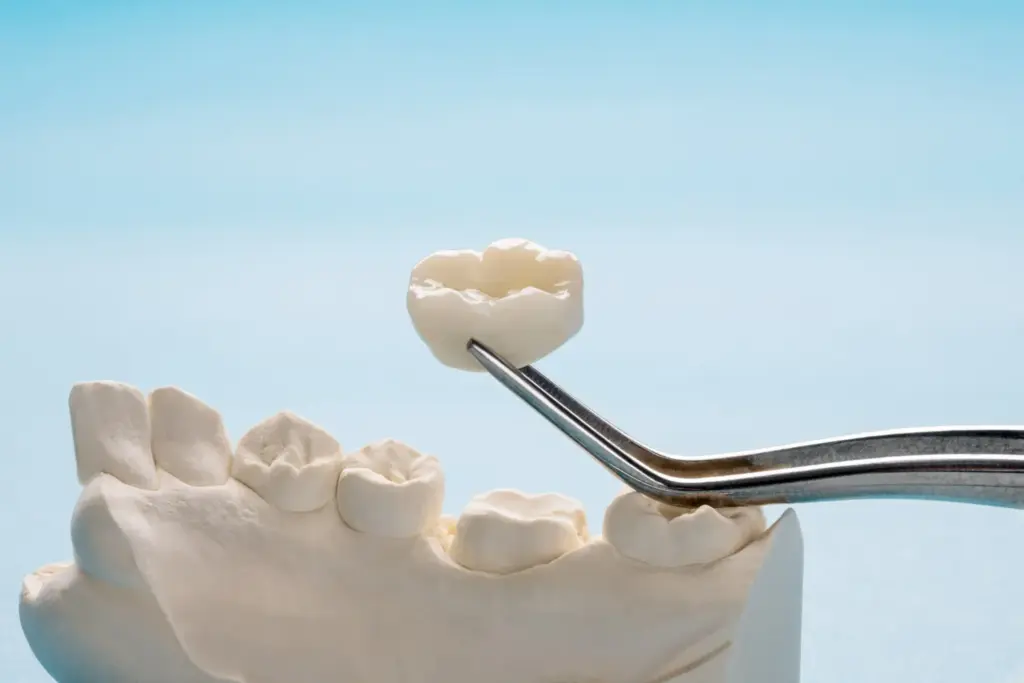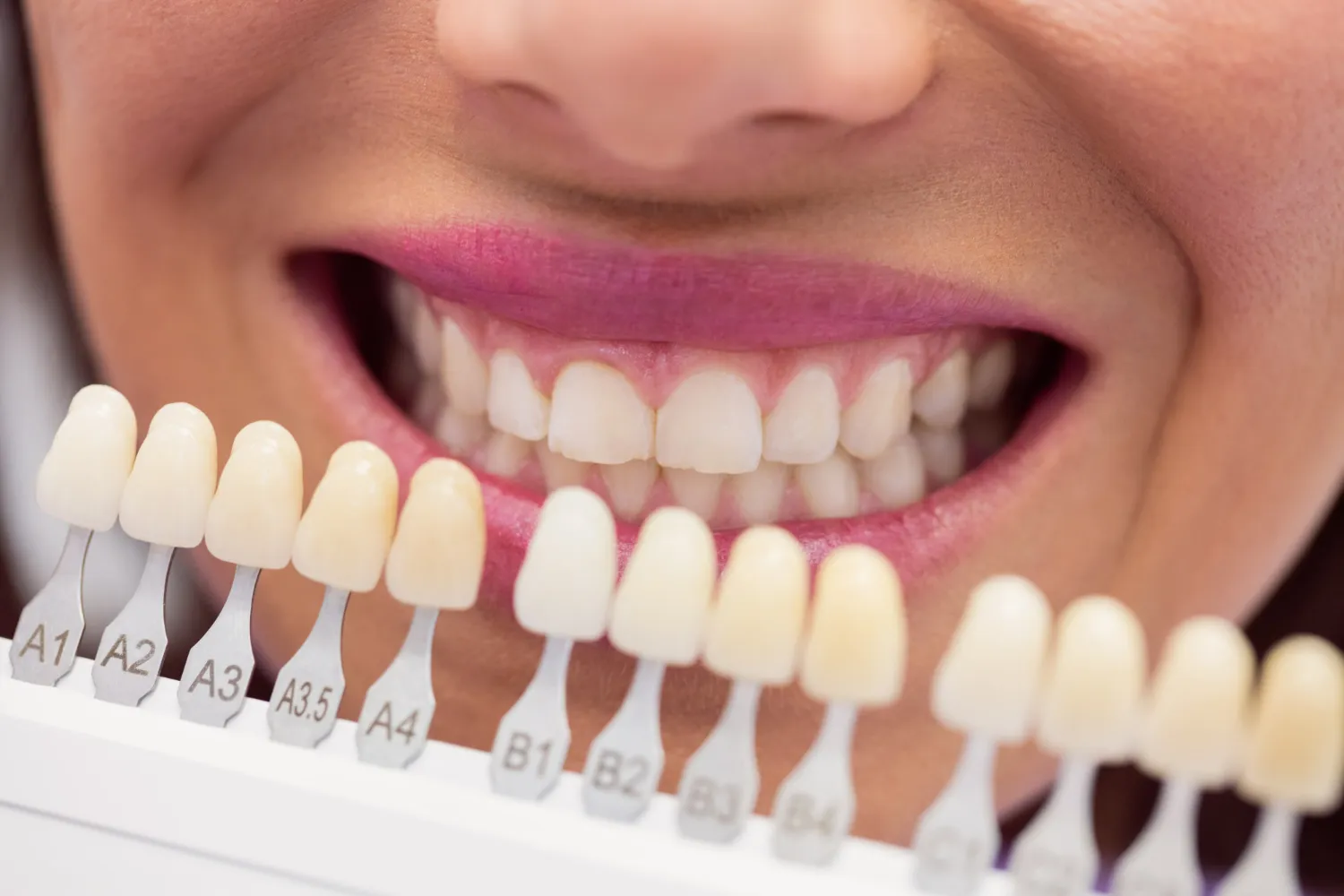Crowns are one of dentistry’s most reliable ways to rescue and strengthen a tooth that can no longer be repaired with an ordinary filling. If you have a broken cusp, a tooth weakened by large decay, or a tooth that has had root canal treatment, a well-made crown can restore shape, bite and confidence without drawing attention to itself. The aim is careful planning, precise workmanship and sensible after-care so the tooth lasts for years.
What exactly is a dental crown?

A crown is a custom cover that fits over the visible part of a tooth. Once bonded in place, it restores form and function while protecting the remaining natural structure. Dentists suggest crowns when a tooth is too compromised for a simple filling, for example, after a fracture, when most of the enamel has been replaced by a large restoration, or when the tooth has been root-treated and needs reinforcement.
For a straightforward overview of how access and indications are arranged, see the NHS page on dental services.
If you would like the bigger picture on how dentists rebuild teeth, our concise guide to restorative dentistry explains where crowns fit alongside other treatments.
Common reasons you may need a crown
- A cracked or broken tooth that cannot be reliably repaired with a filling
- A tooth with a very large filling, leaving little natural enamel to support chewing forces
- Protection after root canal treatment, which reduces the risk of the tooth fracturing
- Improvement of shape, alignment or shade when more conservative options are unsuitable
What are crowns made from?
Modern crowns are chosen to balance strength, fit and appearance. The material your dentist recommends depends on where the tooth sits in your mouth, how you bite and what you want the tooth to look like.
- All-ceramic or lithium disilicate offers lifelike translucency for front teeth with solid strength for everyday use
- Zirconia provides very high toughness for back teeth and heavier bites, while newer versions look increasingly natural
- Porcelain-fused-to-metal has a metal core for strength with tooth-coloured porcelain on top, a proven choice where space is limited
- Gold or high-noble alloy is exceptionally durable and kind to opposing teeth, often selected for molars where appearance is less critical
How is a crown fitted?

Crowns can be provided across two visits, sometimes in a single day, with digital workflows. The priorities are comfort and precision from start to finish.
- Assessment and planning. Your dentist checks the tooth, the gums, the supporting bone and your bite. Any decay is removed and, if needed, root canal treatment is planned first.
- Tooth preparation. A thin layer of enamel is shaped to make space for the crown and to create a clean margin for a secure seal.
- Impressions and shade matching. Digital scans or traditional moulds are taken, and the shade is matched to neighbouring teeth.
- Temporary crown. A short-term cover protects the tooth while the final crown is crafted.
- Fit and bond. The crown is tried in, the bite is adjusted, and it is bonded with high-strength dental cement.
If you are midway through endodontic treatment, it is normal to plan the final restoration once things have settled. The NHS page on root canal treatment explains recovery and after-care in simple terms. For anyone who feels uneasy about longer appointments, many patients choose to read about our option for dental sedation to see how crown visits can feel calmer from start to finish.
Crowns versus other options
Treatment decisions depend on how much healthy tooth is left, how you bite and what you want to achieve. Use this table as a conversation starter with your dentist.
| Situation | Filling | Onlay or Inlay | Crown | Veneer |
| Small to moderate decay or chip | Often suitable | Sometimes | Usually unnecessary | Not for structural repair |
| Very large old filling or cracked cusp | Often insufficient | Often suitable | Common choice | Not indicated |
| After a root canal on a back tooth | Rarely adequate | Occasionally | Typically recommended | Cosmetic only |
| Purely cosmetic aims, such as colour or minor edge wear | Limited | Limited | Sometimes | Primary option |
If you are also comparing ways to replace a missing tooth next to a compromised tooth, our clear explainer on dental bridge vs implant sets out practical advantages and trade-offs that you can discuss at a consultation.
How long do crowns last?
With healthy gums, a balanced bite and good home care, crowns can provide service for a decade or more. How long yours lasts depends on the material, the accuracy of the fit, which tooth is involved and personal habits such as clenching or chewing very hard foods. Scheduling check-ups to match your risk level is sensible. The evidence-based NICE guidance on dental recall supports personalised review intervals rather than a one-size-fits-all timetable.
Practical ways to help your crown last
- Brush twice daily with fluoride toothpaste, and clean between teeth every day with floss or interdental brushes
- If you clench or grind, ask about a custom nightguard to protect both crowned and natural teeth
- Treat teeth kindly by avoiding ice, pen tops and very hard sweets
- Keep regular reviews so small adjustments can be made before issues grow
For everyday prevention between visits, our article on understanding cavities covers habits that protect enamel and the margins around crowns.
Will a crown look natural?
A well-planned crown should blend with neighbouring teeth in shade, shape and surface texture. Front teeth often benefit from layered ceramics that mimic natural translucency. Back teeth may prioritise strength with modern zirconia, which still looks very convincing under normal lighting.
If you are exploring small improvements to edges or minor chips, our page on cosmetic dentistry outlines options that can complement or, in selected cases, postpone the need for a crown, while precise composite bonding can tidy minor wear without full coverage.
Risks, limitations and after-care
Crowns are predictable, but every treatment carries some risk. Temperature sensitivity can occur for a short period after preparation and fitting, typically settling within days or weeks. Decay can still develop at the crown margin if plaque control slips, which is why daily cleaning matters. Porcelain can chip, and cement can loosen under heavy forces. Repairs are often possible, and modern materials reduce these risks, but regular reviews remain important.
FAQs
Do crowns damage the tooth?
A crown requires reshaping to create space and a precise margin. The clinical aim is to remove as little tooth as necessary while achieving a strong, well-sealed result that stands up to daily chewing.
Is a crown always needed after a root canal?
Often, for back teeth, because biting forces are higher, the tooth may be more brittle after treatment. Your dentist will advise based on how much healthy structure remains and how your bite loads that tooth.
How soon can I eat normally?
Once the permanent crown is bonded and your bite feels comfortable, you can usually return to normal eating. It is sensible to avoid very sticky foods for the first day while the cement reaches full strength.
Final thoughts
Crowns remain a dependable way to restore strength, symmetry and comfort when a tooth has been badly damaged. With careful planning, thoughtful material choices and sensible after-care, a crown can look natural and feel solid in everyday life. If you are ready to see how a crown could fit into your plan, our clinicians are happy to help. Start with a relaxed conversation and a clear written proposal by using our contact page.

